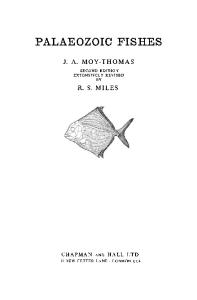Ecomorphology of fishes
Ecomorphology is the comparative study of the influence of morphology on ecological relationships and the evolutionary impact of ecological factors on morphology in different life intervals, populations, species, communities, and evolutionary lineages. Th
- PDF / 49,028,930 Bytes
- 300 Pages / 501.233 x 718.225 pts Page_size
- 87 Downloads / 579 Views
Developments in environmental biology of fishes 16 Series Editor EUGENE K. BALON
Ecomorphology of fishes Editors: JOSEPH J. LUCZKOVICH, PIDLIP J. MOTTA, STEPHEN F. NORTON & KAREL F. LIEM
Reprinted from Environmental biology offishes 44 (1-3), 1995 with addition of species and subject index
SPRINGER-SCIENCE+BUSINESS MEDIA, B.V.
Library of Congress Cataloging-in-Publication Data Eccmorphology of fishes f editors, Joseph J. Luczkovich ... [et al.]. cm. -- , 30
+'
·~
5
+'
~
10
d
70
,-., 35 E 30
Q)
t t
5 0
I
•
-.
I
•
"
~
20 10
I
Fig. 5. Head length, head length protruded, mouth width, body depth, pectoral fin length, gill raker length, gill raker spacing, and eye diameter of ten species of seagrass fishes. Mean± one standard deviation indicated. Species that are not significantly different indicated (N = 30, Mann-Whitney U-test, p = 0.05).
group with intermediate overlap levels includes C. schoepfi, F. simi/is, and E. gula. A third group including A. felis, S. scovelli, and L. rhomboides had relatively little dietary overlap.
Dietary-morphometric correspondence
Canonical correspondence analysis (CCA) and detrended CCA (DCCA) ofthe 15 morphological variables and dietary data indicated that the morphological variables were poorly related to the first four environmental (dietary) axes (eigenvalue = 0.033 on Axis 1, Table 4). Only 3% of the morph-
ological variance could be accounted for by dietary axis 1. Analysis of the seven morphological variables related to microhabitat utilization revealed a similarly poor relationship (eigenvalue = 0.055 on Axis 1, Table 4). Eigenvalues of approximately 0.3 and higher are quite common in ecological applications (ter Braak 1988, Jongman et al.1987), and ordination axes with very low eigenvalues (< 0.02) should be discarded (ter Braak 1988). Because of the poor relationship between morphological and dietary axes in this study, further analysis of the axes was not warranted.
49
60
E E 50
~
e
f
E 4 E
Q, 40 c
2
2
20
Q_
10
(.) Q)
_c
Q,
f!
30
.Cil
~
"'0
'0 dl
0 Ill
:::J' dl
0
()
dl
"'0
....
"'
:::J'
:
., :::J'
0
0
3
'0
0
.,
Q.
:::J'
..,
C'
dl
"'
r
0
3 C'
0 Q.
dl
"' Fig. 6. Cluster analysis of fifteen untransformed morphometric variables for ten species of seagrass fishes. Clustering by the Bray-Curtis percent dissimilarity index utilizing the flexible strategy (N ~ 30).
the combined analysis additional morphometric variables were considered (the coded variables). In addition these variables had inherently less variability being integer values. Perhaps instead of coded variables, features such as eye position and caudal fin shape should be quantified by continuous values derived by multidimensional shape analysis. These continuous values would have more inherent variation than the coded integer values. In both analyses certain species groups were apparent. The first group











